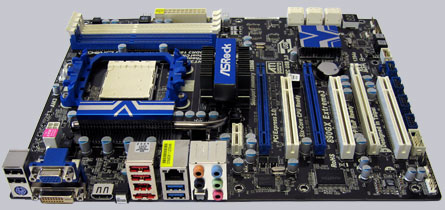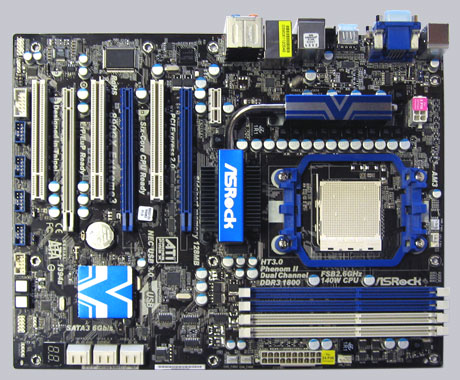
Result and general impression

++++ The ASRock 890GX Extreme3/A/ASR motherboard has a price of approx. 100 Euro (04/2010) and is thus in the middle price segment of the Socket AM3 motherboards.
The new ASRock 890GX Extreme3 socket AM3 DDR3 motherboard supports USB 3.0, SATA3 and eSATA3 drives. It is based on the AMD 890GX chipset with SB850 southbridge and offers a fast integrated HD4290 GPU with sideport memory. The performance and the basic equipment of this high-end ASRock motherboard is really amazing, and it is very interesting to see how easy this platform can be overclocked.
True 333 means USB3.0, SATA3 and eSATA3 as shown on the box:
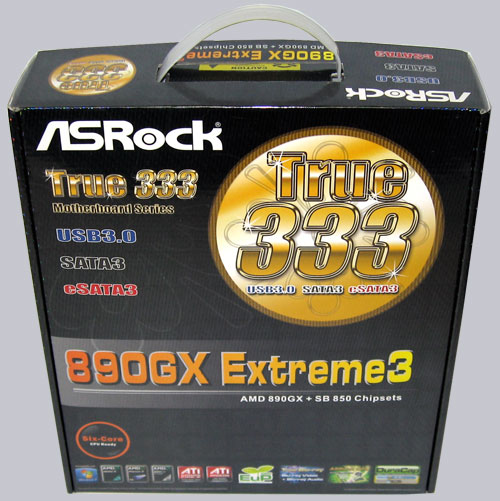
With a first look to the 890GX Extreme3 one will see that this is a very high-quality motherboard from the company ASRock. Heatpipe cooling and high-quality solid caps capacitors dominate on the well structured layout of the nice blue/white motherboard design:
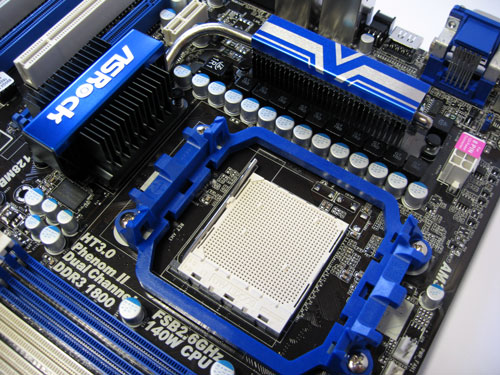
Here one can see almost all novelties on one view. USB 3.0 ports over the new NEC chip, SATA3 ports up to the lighted Power and Reset button, and the 7-segment post code display:
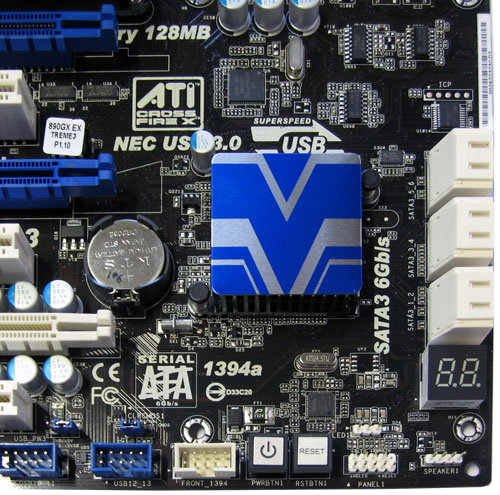
Here’s another picture of the post code display and the illuminated button in operation. It’s easy to find these buttons even without light inside of the PC. And the postcode display shows if or where a problem can be found:
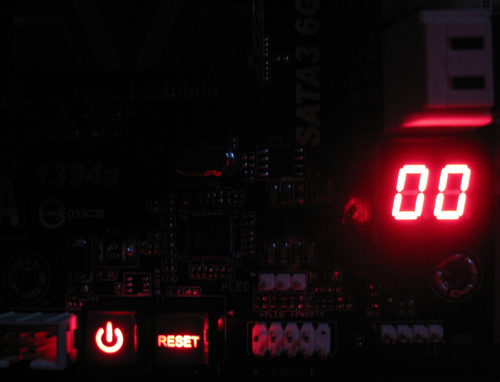
Equipment and other features …
ASRock’s 890GX Extreme3 motherboard comes with a manual, two quick reference guides, one DVD, one eSATA slot bracket, four SATA data cables, one SATA power cable and one ATX I/O shield.
Expansion cards …
This 3-Way CrossFireX motherboard offers three PCI Express 2.0 video card slots, whereby either one Radeon video card can operate with x16 band-width, or two can operate in x8 mode, or two in x8 mode and one in x4 mode. A SLI/XFire Switch card is not necessary to get the optimal performance for the single, CrossFireX or 3-Way CrossFireX operating. If one like only use one video card on the 890GX Extreme3, one should insert the PCI Express video card into the blue PCIe2 slot, in order to get the fastest x16 bandwidth. By the way one could use theoretically also several nVidia video cards, however officially not as SLI, but only the output to several monitors would be supported. Additionally to the three PCI Express 2.0 slots there are 3 PCI slots and one x1 PCIe 2.0 slot.
Memory …
The ASRock 890GX Extreme3 can be equipped with up to four DDR3 modules and is expandable depending upon operating system used (see list) to maximally 16 GB memory.
The Socket AM3 motherboard supports DDR3 memory modules and can be optimized in the BIOS for DDR3-800, DDR3-1066, DDR3-1333 or DDR3-1600 and faster Dual Channel modules. DDR3-1800 or higher clock-rates are currently only possible with overclocking, but for this reason you can visit ocinside.de … 😉
Hard disk drive connectors …
The motherboard offers no more IDE connector conventional ATA 133 drives! It also comes without the obligatory floppy connector. But this 890 GX Extreme 3 board offers six SATA 3.0 connectors (6 Gb/s), one eSATA 2.0 port, and one additional eSATA slot bracket which can be connected internally to one of the six SATA3 ports. Who like to use the SATA3 Port6 external as eSATA3, have to set the SATA3_6 mode in the BIOS to Gen2, otherwise it can be set to Auto. The S-ATA 3 ports supports RAID 0, RAID 1, RAID 0+1, RAID5, NCQ, AHCI and the Hot Plug function in AHCI mode (AHCI stands for Advanced Host Controller Interface).
The manual and the included DVD contains all basic information to manage a new installation of Windows XP, Windows Vista or Windows 7 with S-ATA3 hard disk drives, and how to make a RAID installation. 32-Bit and 64-Bit drivers for Windows XP, Windows Vista and Win7 are provided on the DVD and can be downloaded on the ASRock support page.
USB and Firewire …
The board has two USB 3.0 connectors and four USB 2.0 connectors at the ATX panel, four internal USB 2.0 plugs for up to eight optional USB2 ports. So ASrock utilize the latest USB3.0 technology up to 5 Gb/s with the NEC MPD720200 chip and the full 12 USB ports of the chipset. Additionally, the board offers one IEEE1394 Firewire port at the I/O panel and another optional internal IEEE1394 port.
Network …
The Realtek RTL 8111E chip is integrated on the ASRock 890GX Extreme3 motherboard and offers a WoL capable 10/100/1000 network connector at the ATX panel.
Serial and parallel port …
This motherboard does not provide a parallel port and the serial port is only optionally available as internal connector.
Sound …
The ASRock 890GX Extreme3 motherboard is equipped with the VIA VT2020 HD audio codec with content protection, which supports 7.1 surround sound for example analog over 6x 3.5mm connectors at the ATX panel or over the internal analog connector.
For the digital output there is one internal HDMI SPDIF out connector available to connect it for example with a SPDIF cable to a HDMI suited video card, in order to get the digital audio and video signal to a HDMI equipment like a HD-Ready LCD TV. Over the BIOS it’s possible to set the sound output to the integrated HDMI port. Additionally there is also an optical digital SPDIF output and premium Blu-Ray audio support. So most users don’t need to buy an additional sound card with digital outputs.
Graphics …
The new ATI Radeon HD4290 IGP of the AMD 890GX chipset is also without overclocking faster than the previous IGPs and support in addition DX10.1. The benchmark result of the HD4290 (AMD 890GX) is with 3DMark06 2249 points a little bit over a HD3300 (AMD 790GX) with 3DMark06 2235 points (700 MHz GPU on a M3A790GXH/128M) and HD4200 (AMD 785G), with 3DMark06 1571 points (500 MHz GPU clock on a M3A785GXH/128M). With Hybrid CrossFireX technology in combination with an additional ATI video card, the benchmark result would be higher on all three IGPs. However, only few video cards are applicable (e.g. a ATI Radeon HD3450) officially to cooperate with the integrated video chip as Hybrid CF. AMD and ASRock made a good job with their onboard graphics solution and achieve higher performance on the same frequeny with lower power consumption nearly every half year.
A comparison of the benchmark results by using a nVidia GTS250 PCI Express video card achieved also a visible difference of 13057 points instead of 12510 points with the M3A790GXH/128M.
Furthermore the HD 4290 video processor supports DirectX 10.1, has integrated 128MB Sideport RAM on the 890GX Extreme3 motherboard, supports HDCP, Full HD 1080p and offers thanks to onBoard HDMI connectors optimal conditions for a Home theatre PC.
Here is a picture of the ATX panel connectors:
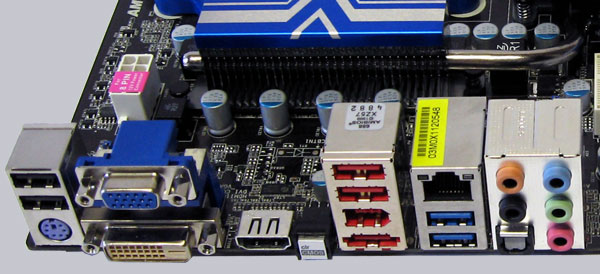
From left to right one can see 2x USB 2.0 ports, the PS/2 connector for a PS/2 keyboard, 15-pol Sub-D VGA, DVI-D VGA, HDMI, a Clear CMOS button, 2x USB 2.0 and IEEE1394 and eSATA, 2x USB 3.0 ports and RJ45 Gigabit LAN, optical SPDIF out and 6x 3.5mm jacks for analog sound.
BIOS and Overclocking …
Let us continue with BIOS options and BIOS overclocking. By pressing F2 or Del, you get access to the AMI BIOS with all important hardware settings.
The P1.10 BIOS offers a lot of DDR3 memory settings like e.g. the memory frequency setting from 400 MHz over 533 MHz and 667 MHz on up to 800 MHz (DDR3 800/1066/1333/1600). The frequency of all memory modules is calculated and shown immediately after changing the reference clock and makes it much easier to adjust the right RAM frequency.
The host clock is adjustable from 150 MHz up to 500 MHz and the HT (hypertransport) frequency is adjustable from 1x to 10x (200 to 2000 MHz). The PCIe frequency is adjustable from 75 MHz up to 250 MHz and with the asynchronous or synchronous setting of the CPU/PCIe bus, it is possible to increase the host frequence independent of the PCI and PCIe clock. Changes to the CPU frequency is directly shown in the BIOS, so if you change for example the reference clock, you will see how high the CPU frequency would be with each divisor on this setting.
With asynchronous clock setting, it was possible to reach a enormous high 330 MHz reference clock and with onboard GPU it was possible to overclock the reference clock up to 260 MHz. Some may think that the reference clock is no longer important for overclocking of e.g. Black Edition processors with free multiplier selection, but the reference clock is still very important for good PC overclocking results. And of course not every user like to spend more money for these AMD BE CPUs.
The boot failure guard was checked in this review as well and it was possible to start the PC on standard values with too high overclocking settings without using the Clear CMOS Jumper. It was just necessary to press the RESET button. BTW as already mentioned before, this board has an additional Clear CMOS button at the backpanel. the question is if and how often it is pressed unintentionally, but a BIOS password will protect it.
Another interesting feature is the so-called UCC BIOS setting. With the Unlock CPU Core feature it was possible to unlock deactivated CPU Cores. Unfortunately it’s not possible with every Phenom II CPUs, but the BIOS options are nevertheless present and this is surely for some buyers an important purchase aspect. The UCC option was called Advanced Clock Calibration or short ACC on previous motherboards, but the current AMD chipset wouldn’t support ACC without an addtional IC.
Instead of ACC now with additional UCC chip to unlock CPU Cores of some processors:
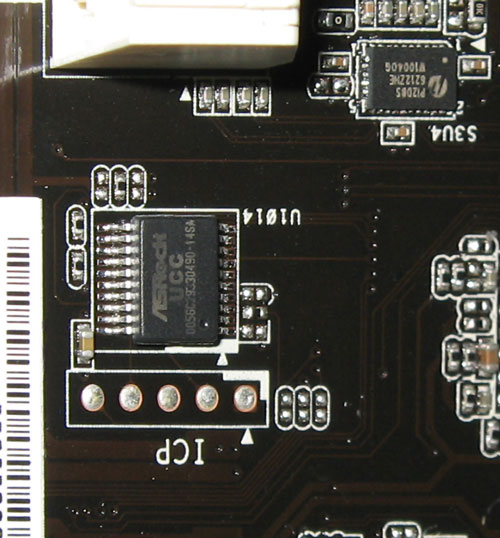
Furthermore, this board offers a NB voltage from 0.6000 Volt to 1.7500 Volt, a Vcore setting on the Phenom II test CPU from 0.6000 Volt to 1.7500 Volt, a HT voltage setting from 1.200 to 1.820 Volt and a few more settings to overclock the platform more stable: SB 1.10 – 1.40 Volt, mGPU 1.108 – 1.794 Volt, Sideport memory voltage 1.50 – 1.80 Volt, CPU VDDA 2.56 – 2.70 Volt and PCIe VDDA 1.81 – 1.92 Volt. The DDR3 memory voltage can be set between 0.987 Volt up to 1.995 Volt, whereby the memory voltage was detected as 1.615 Volt by the P1.10 BIOS at Auto setting. This would be much higher than the JEDEC standard for DDR3 modules. The GPU can be adjusted from 350 MHz to 2000 MHz and the Sideport memory can be clocked from 533 MHz to 1700 MHz.
Who don’t know all of these settings or who don’t like to know more about overclocking, can try to use the turbo 30 menu.
In the turbo 30 menu one can increase the system performance automatically to 30% if the components support it and with the necessary luck. Just select the System Performance Increases 30% setting in the OC Tweaker Turbo30 menu:
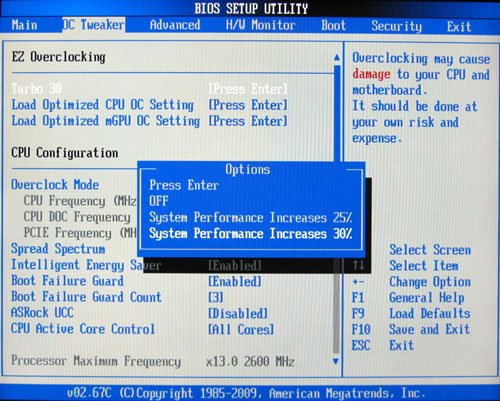
Then some components of the system will be overclocked by 30 percent. The 2600 MHz CPU is now overclocked to 3120 MHz:
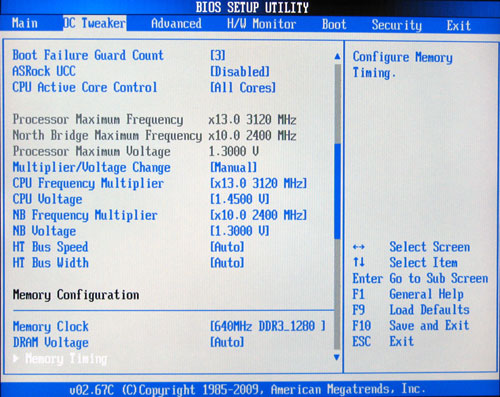
And also the GPU is tuned. As special BIOS feature one can store three different BIOS settings also with a desired name. Thus one can save for example balanced BIOS settings, overclocking settings and underclocking settings in a user profile of the BIOS:
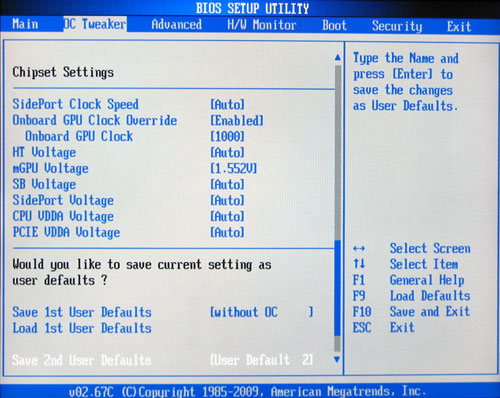
The downclocking or underclocking was also tested in this review. It was possible to lower the AMD Phenom II 710 CPU multiplier over the BIOS to 0.5x and th processor can be underclocked in such a way with 150 MHz reference clock to approx. 75 MHz. Even if probably nobody like to underclock an AMD Phenom II 710 processor from 3x 2600 MHz to 3x 75 MHz CPU clock. With unlocked fourth core of the AMD Phenom II 710 CPU it was possible to underclock down to 100MHz.
Underclocking and OverClocking is outside of the manufacturers specification, so it’s necessary to have a bit luck and ASRock give several options to overclock or underclock the system.
Several energy saving options are available on this ASRock motherboard, because the ASRock 890GX Extreme3 board offers the Away Mode, which is particularly very important when using Microsoft Windows MCE (Media Center Edition) to e.g. record TV shows when the PC system is nearly powered off. Who like to boot much faster, should try the ASRock Instant Boot function. And IES (Intelligent Energy Saver) reduces the power consumption by lowering voltages on less load. The features can be e.g. adjusted with the included OC Tuner Software and in our test it was also possible to overclock with activated CnQ feature. The current consumption of the test PC with AMD Phenom II 710 X3 CPU, onBoard HD 4290 graphics, 4GB DDR3-1333 memory and hard disk drive was without overclocking and depending upon load between approx. 44 Watt and 71 Watt. The current consumption with 30% OC option was depending upon load between approx. 65 Watts up to 113 Watts, but with a benchmark performance increasement of approx. 20-30 percent.
The SB850 southbridge temperature was only 38.2°C after several benchmarks.
The BIOS of the passive cooled 890GX Extreme3 motherboard supports by the way a CPU Quiet Fan option (temperature fan control) for 4-pin CPU fans. Furthermore there is on this ASRock board a fan controller function for case fans. Of course it is not as comfortable as a conventional fan controller and it is not possible to use it with all fan types, but it should help some users to get a more silent PC.
ASRock offers addionally a very comfortable option to flash a BIOS update. By the so-called ASRock Instant Flash option (Advanced BIOS) or during the PC start one can get into the ASRock Instant Flash utility. Hereby one can very easy upgrade a downloaded ASRock BIOS without further boot CD, boot stick, boot disk, etc. Just start the ASRock Instant Flash utility. Then select a BIOS Flash ROM from any FAT formatted device like an USB Stick, then the BIOS will be flashed without without any boot medium.
Unfortunately the BIOS version P1.10 (latest version at the review date) had some little faults in some points, whereby e.g. the DOC dynamic CPU overclocking value gave some very strange values and in the BIOS some hieroglyphics characters were shown. And it was only sporadically possible to enter the BIOS with a USB keyboard, which was especially with the many overclocking tests very annoying. Hopefully ASRock publishes very fast an error free BIOS update for this motherboard, because the BIOS version P1.10 is very buggy and should be seen rather as beta version.
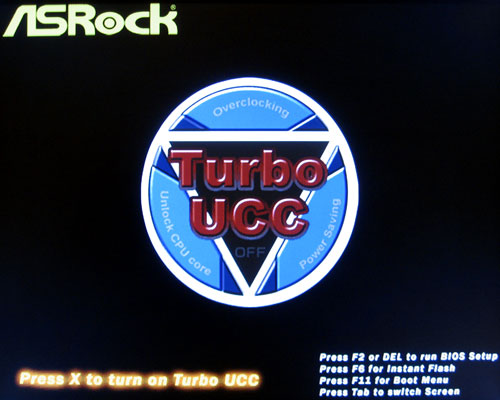
It took less than 24 hours, until ASRock published a new BIOS version after our ASRock 890GX Extreme3 review. Not all bugs has been fixed with this update, but it showed that ASRock keep at it and that they already improved their first incorrect BIOS. Our review announcement is now about 6 weeks ago and in the meantime ASRock send us a lot of unofficial and official BIOS versions for this ASRock 890GX Extreme3 board. Currently, there is officially the BIOS version P1.80 available for download and this BIOS is a reason to test the motherboard once again with this BIOS.
With the P1.80 BIOS ASRock fixed all bugs specified above. No more hieroglyphics characters in the BIOS, it’s now also possible ot enter the BIOS without a problem with an USB keyboard, the voltage of the memory modules is corrected and the CPU DOC value has no more problems. Additionally, a few new functions were integrated, among other things, one can deactivate the Debug LED. Thus, the hard work of ASRock was worthwhile in any case and the current BIOS version is thereby very recommendable – thanks for the good and friendly ASRock support.
Result …
The ASRock 890GX Extreme3 AMD Socket AM3 motherboard for DDR3 memory modules offers with the AMD 890GX chipset enormously high overclocking results, high performance and a lot of modern features at a good price.
The basic equipment is very great with two USB 3.0 ports, up to twelve possible USB 2.0 ports, two possible IEEE1394 ports, six SATA3 ports with RAID support at which one SATA port can be used as eSATA3, another eSATA2 connector, Gigabit LAN, 7.1 sound, analog sound output over six connectors, digital sound output over one optical and one internal SPDIF connector and video output over D-Sub, DVI-D or HDMI. This is really amazing!
All in all the board can absolutely convince with almost all test criteria. Retro fans will surely miss the floppy disk connector, conventional IDE connectors, parallel port and a few other older standards, because these standards have been removed for new technologies. On the other side there are a lot of ways, to get the older interfaces with inexpensive PCI I/O cards, PCIe I/O cards, SATA to IDE adapter, USB to LPT adapters or similar hardware, and can get many new improvements with clearly faster interfaces on this motherboard.
The BIOS difficulties specified above unfortunately prevents the Overclocking Dream award, but for sure ASRock will offer a new BIOS version very soon.
Update: With the clearly improved BIOS version P1.80, the ASRock 890GX Extreme3 motherboard received now the Redaktion ocinside.de OverClocking Dream Award 05/2010.
Here you can buy the ASRock 890GX Extreme3 motherboard. *Ad
Special thanks to ASRock for their support.
Picture
* All Socket AM2 / AM3 PCIe motherboard reviews since 01.01.2010 are based on an AMD Phenom II 710 X3 CPU, 1x Gigabyte GV-N250OC-1GI Nvidia GTS250 PCI Express 2.0 video card, 2x Sapphire HD4870 512MB ATI Radeon HD4870 PCI Express 2.0 video cards, 2x 1024MB Crucial Ballistix Tracer DDR2-1066/PC2-8500 memory modules on DDR2 mainboards or 2x 2048MB Crucial Ballistix Tracer DDR3-1333/PC3-10600 memory modules on DDR3 mainboards, and the following software configuration: Microsoft Windows 7 RC, Microsoft Windows Vista Ultimate, Windows XP SP2, SiSoftware Sandra 2010c, Futuremark 3DMark03, 3DMark06 and 3DMark Vantage (the software is available in the Links & Downloads section). All benchmark results only offer a comparison among themselves for a rough motherboard performance comparison.
Back to the AMD Athlon 64 and AMD Phenom motherboard comparison !


